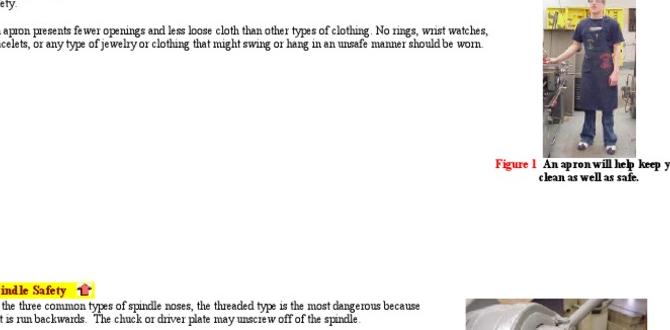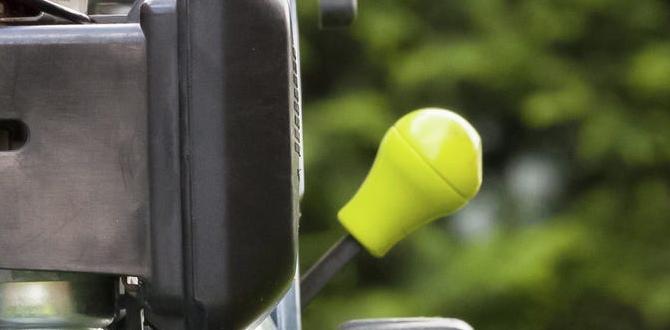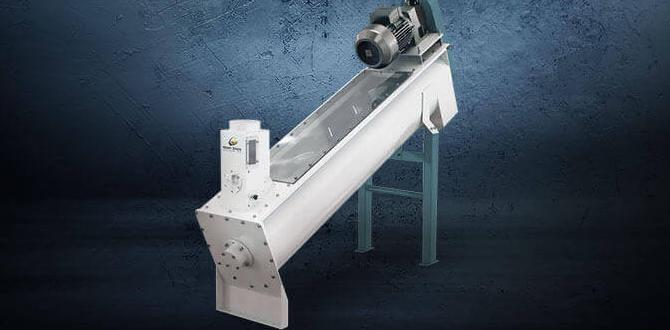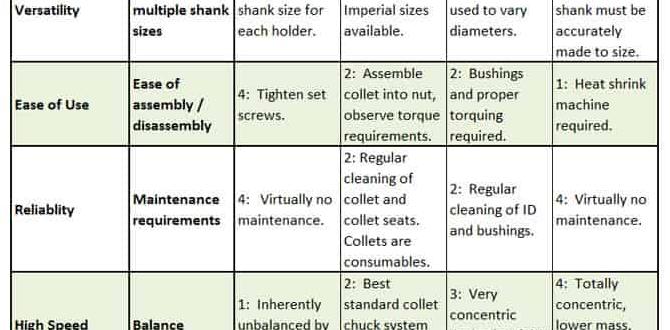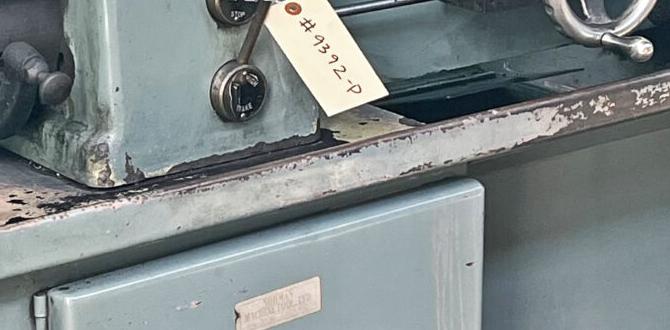Wood lathe tool sharpening is crucial for clean cuts and a smooth woodworking experience. Mastering essential techniques ensures your chisels and gouges perform at their best, giving you control and confidence with every turn of the wood.
Welcome to Lathe Hub! If you’ve ever wrestled with a wood lathe tool that just won’t cut cleanly, leaving jagged edges and frustrating divots, you know how vital sharp tools are. It’s a common challenge for beginners, but the good news is that mastering wood lathe tool sharpening is entirely achievable. With the right approach and a little practice, you can transform dull tools into precise cutting instruments. This guide will walk you through proven essential techniques, making the process straightforward and rewarding. Get ready to experience the joy of effortless turning!
Why Sharp Tools Matter for Wood Lathe Users
Sharp tools are the unsung heroes of successful woodturning. Think of them as an extension of your own hands. When a wood lathe tool is sharp, it seizes the wood fibers cleanly. This means less force is required from you, leading to smoother cuts, reduced tear-out, and a much more enjoyable turning session. Dull tools, on the other hand, can be dangerous. They require more pressure to cut, which can lead to the tool “catching” the wood. This unexpected movement is a common cause of accidents and injuries in the workshop. Beyond safety, sharp tools also produce better results. You’ll find your workpieces smoother, requiring less sanding, and your overall project time can be significantly reduced. It’s a fundamental skill that pays dividends in both quality and safety.
Essential Wood Lathe Tools: What Needs Sharpening
When you’re working with a wood lathe, a few key tools will become your go-to for shaping and refining your projects. Keeping these tools sharp is paramount to their effectiveness and your safety. Here’s a breakdown of the most common wood lathe tools that require regular sharpening:
- Gouges: These are the workhorses for most turning tasks. There are several types, including:
- Fluting/Carving Gouges: Used for decorative flutes, beads, and shaping.
- Bowl Gouges: Designed for creating bowls and platters, with various grind types (e.g., fingernail, conventional). These are arguably the most frequently sharpened tools for bowl turners.
- Spindle Gouges: Ideal for spindle work, creating beads and coves on furniture legs and similar items.
- Scrapers: While not “sharpened” in the same way as gouges, scrapers have a burr that needs to be created and maintained. They are used for smoothing tenons, inside bowls, and on flat faces. Common types include:
- Round Nose Scrapers
- Flat Scrapers
- Hook Scrapers
- Skew Chisel: A versatile tool used for shearing cuts, creating sharp details, smoothing, and finishing. Skew chisels have a specific bevel angle that needs to be maintained.
- Parting Tool: Used to cut narrow grooves or to separate pieces of wood.
- Narex (Spear Point) Scraper: A specialized scraper with a pointed tip for detailed work.
Understanding the function of each tool helps in knowing how its cutting edge should be maintained. For instance, the aggressive cutting edge of a bowl gouge differs from the shearing edge of a skew chisel.
Understanding Cutting Edges and Bevels
Before we dive into sharpening techniques, it’s essential to grasp the basics of a tool’s cutting edge. For most woodturning tools, the cutting action is achieved through a sharp bevel. The bevel is the angled surface that meets the wood. The angle of this bevel, and how cleanly it’s formed and maintained, directly impacts how the tool cuts.
- Primary Bevel: This is the main angled surface that forms the cutting edge.
- Secondary Bevel (Facet): Often, a small, steeper angle is ground just above the primary bevel. This secondary bevel supports the primary bevel and makes contact with the wood for a split second before the primary bevel engages. This helps to prevent the tool from digging in too deeply and contributes to a smoother cut.
- Angle: The specific bevel angle varies depending on the tool and its intended use. For example, bowl gouges often have bevels around 40-50 degrees for aggressive cutting, while spindle gouges might have slightly steeper bevels. Skew chisels have unique bevel angles for their shearing action.
When sharpening, our goal is to either refinish the existing bevel or create a new one on a damaged or misshapen edge, ensuring it’s sharp, consistent, and free of defects. A keen edge means the metal is honed to a microscopic sharpness, allowing it to slice wood fibers rather than rip them.
Sharpening Methods: Grinding vs. Honing
There are two primary methods involved in keeping your wood lathe tools sharp: grinding and honing. They serve different purposes and are often used in conjunction.
Grinding: Reshaping and Repairing
Grinding is used when a tool is significantly dull, chipped, or has lost its proper shape. It involves removing more metal to re-establish or repair the bevel. This is typically done using a grinding wheel, often found on a bench grinder or a dedicated grinder designed for turning tools.
- Pros:
- Effective for significant repairs and reshaping.
- Can quickly remove damaged metal.
- Cons:
- Can easily overheat the tool’s temper if not done carefully, making the steel brittle.
- Removes more metal, shortening the tool’s lifespan.
- Requires careful technique to maintain the correct bevel angle.
Honing: Maintaining the Edge
Honing is for maintaining an already established edge. It’s a touch-up process that removes microscopic imperfections and realigns the very fine edge of the bevel. Honing is typically done with sharpening stones (water stones, oil stones, diamond stones) or specialized strops.
- Pros:
- Removes minimal metal, extending tool life.
- Can be done quickly and frequently.
- Refines the edge to a very keen sharpness.
- Cons:
- Not effective for repairing significant damage or reshaping the bevel.
- Requires a consistently sharp tool to start with.
For most woodturners, a combination of occasional grinding (when absolutely necessary) and frequent honing will keep tools in prime cutting condition.
Essential Sharpening Equipment
To effectively sharpen your wood lathe tools, you’ll need a few key pieces of equipment. Don’t feel overwhelmed; you can start with the basics and add more specialized items as you progress.
For Grinding:
- Bench Grinder: A standard bench grinder with at least 1/4 horsepower is ideal. It should have wheels suitable for sharpening, such as aluminum oxide or white aluminum oxide.
- Tool Rests: Adjustable tool rests are crucial for setting and maintaining consistent bevel angles during grinding. Many grinders come with basic rests, but aftermarket ones can offer more adjustability.
- Water/Coolant: For grinding ferrous metals, sometimes recommended to keep the tool cool. However, for woodturning tools, slow-speed grinders (often ~4000 sfpm) with little to no sparking are common and don’t typically require extensive cooling if done carefully, as they remove less material slowly.
- Diamond Dresser: To keep your grinding wheels true and flat, especially if they develop a dished profile.
For Honing:
- Sharpening Stones:
- Water Stones: Popular for their fast cutting action and ease of use. They come in various grits; a common progression for woodturning tools is a 1000-grit stone for general sharpening and a 4000-6000 grit stone for refining the edge.
- Diamond Stones: Durable and long-lasting, they cut quickly and don’t require flattening. A set of coarse, medium, and fine stones is versatile.
- Oil Stones: Less common now for wood tools, but provide a fine edge. They require oil as a lubricant.
- Stropping Compound: This is a fine abrasive paste applied to a leather strop. It’s used with the strop to achieve a razor-sharp, mirror-polished edge. Common compounds include Chromium Oxide.
- Leather Strop: Usually mounted on a flat surface (like a piece of wood) or on a dedicated stropping wheel. This is the final step to remove the burr and polish the edge.
- Sharpening Jigs/Fixtures: While not strictly essential for all tools, jigs can be immensely helpful, especially for beginners, in consistently holding the tool at the correct bevel angle against the stone or wheel. Examples include the Wolverine Grinding Jig and various other setups for specific tools.
It’s recommended to look into specialized jigs for woodturning tools, like the Oneway Wolverine or comparable systems. These secure your tools and allow you to easily reproduce bevel angles.
Proven Essential Techniques: Step-by-Step Sharpening
Let’s break down the sharpening process. We’ll cover the most common tools: the bowl gouge and the skew chisel. The principles can be adapted to other tools.
Sharpening a Bowl Gouge (e.g., Fingernail Grind)
The fingernail grind is popular for bowl gouges because it offers a good balance of aggressive cutting and control. This grind creates a rounded flute shape that allows for sweeping cuts.
Method 1: Using a Bench Grinder with a Jig
This is a common and efficient method for establishing and maintaining the fingernail grind.
- Set up Your Grinder: Ensure your bench grinder has a grinding wheel suitable for tool steel. A slow-speed grinder is often preferred to prevent overheating. Mount a sharpening jig (like a Wolverine). These jigs feature a “V-arm” that holds the tool shank and allows it to pivot, maintaining the bevel angle.
- Set the Bevel Angle: Most fingernail grinds use a bevel angle between 35-45 degrees. Adjust your jig or tool rest to achieve this angle. You’re aiming for a shape reminiscent of a fingernail, with the edge sweeping up at the sides.
- Position the Gouge: Insert the bowl gouge into the jig’s V-arm. The flute should be facing upwards. Rest the gouge against the tool rest so the bevel is presented to the grinding wheel at your chosen angle.
- Grind and Rotate: Turn on the grinder. Gently bring the bevel of the gouge into contact with the wheel. Move the gouge side-to-side across the wheel to grind evenly. For the fingernail grind, you’ll need to slightly rotate the gouge shank as you move it, allowing the wheel to grind the curved flute shape. Don’t grind for too long in one spot.
- Check for a Burr: Grind one side until you feel a small “burr” or wire edge along the opposing cutting edge. This indicates you’ve ground all the way to the edge.
- Switch Sides: Carefully reposition the gouge in the jig to grind the other side of the bevel, bringing it to meet the first side. Again, rotate and move the tool to create the symmetrical fingernail shape. This process mirrors the first side until you feel a burr along the entire length of the new edge.
- Minimize Heat: Take breaks to let the tool cool. Overheating can ruin the temper of the steel. It’s better to do multiple light passes than one heavy one.
- Hone the Edge: Once ground to shape and with a visible burr, move to your sharpening stones or strop.
Method 2: Freehand Grinding (More Advanced)
This requires more practice and feel.
- Set up your tool rest.
- Hold the gouge securely, presenting the bevel to the wheel at the desired angle.
- Use a combination of rocking and sweeping motions to grind the bevel, trying to maintain a consistent angle and create the fingernail shape symmetrically.
- Check for the burr on both sides.
- Proceed to honing.
Sharpening a Skew Chisel
Skew chisels are trickier because of their angled geometry. The goal is to maintain the cutting edge and the specific bevel angle. There are two common grinds: the traditional (symmetrical) and the swept-back (asymmetrical) grind. We’ll focus on the traditional grind.
Method 1: Using a Bench Grinder with a Jig
- Set up Grinder and Jig: Use a tool rest or a jig. For a traditional skew, you’ll likely be grinding two bevels that meet at a point. A simple tool rest is often sufficient if you can maintain the angle.
- Set the Bevel Angle: Skew chisels typically have bevels around 25-35 degrees. Ensure your angle is consistent.
- Position the Skew: Place the skew on the rest with the cutting edge angled so that the bevel is presented to the wheel. You want to grind the face of the bevel.
- Grind and Move: Move the skew side-to-side across the wheel. The trick here is to maintain the angle while also moving the tool so you don’t create a “dish” shape on the wheel and don’t overheat a single spot.
- Grind One Side: Grind until you raise a burr along the opposite cutting edge.
- Switch Sides: Carefully flip the skew and grind the other side, again moving side-to-side to meet the first bevel precisely. The goal is to form a symmetrical point.
- Maintain Integrity: Avoid grinding too much metal away, and always check for heat.
- Hone the Edge: Proceed to honing.
Method 2: Freehand Grinding
This is challenging due to the skew’s geometry. It requires significant practice to hold the tool and maintain the exact angle across the entire bevel while also moving it accurately.
Honing and Stropping for a Razor Edge
After grinding, the tool will have a burr. Honing and stropping remove this burr cleanly and polish the edge to razor sharpness.
- Stones for Honing: Start with a medium grit stone (e.g., 1000 grit) if the edge isn’t perfect. Hold the tool at the same bevel angle used during grinding and make several passes.
- Finer Grit Stones: Move to a finer grit stone (e.g., 4000-6000 grit) to refine the edge. Repeat the passes at the same angle.
- Stropping: This is critical for a truly sharp edge.
- Using a Strop Board: Apply a small amount of stropping compound to the leather. Hold your tool at the same bevel angle you’ve been using. Lay the bevel flat on the strop and make backward strokes (pushing the tool away from the edge). Alternate sides, making several passes on each.
- Using a Strop Wheel: These wheels have leather surfaces, often with compound already applied, that spin at variable speeds. Present the bevel to the spinning wheel and make backward strokes.
- Check for Sharpness: A well-sharpened tool should be able to shave hair off your arm or forearm cleanly. Another test is to see if it can cleanly slice a piece of paper held vertically.
It’s important to replicate the bevel angle accurately. Many turners use jigs not just for grinding but also for consistent stropping angles.
Sharpening Specific Tools: Scrapers & Parting Tools
While gouges and skews are ground and honed, scrapers and parting tools often require a slightly different approach, focusing on creating a sharp burr or a keen edge with minimal material removal.
Sharpening Scrapers
Scrapers don’t have a traditional bevel in the same way as gouges. Instead, their cutting action comes from a “burr” or “wire edge” formed at their working edge by burnishing or light grinding.
- Burnishing: This is the primary method for rejuvenating a scraper’s edge. A burnisher (often made of hardened steel or carbide) is used to “iron out” or roll over the edge, creating the burr. You rub the burnisher firmly along the edge at a slight angle.
- Light Grinding/Honing: If the scraper is significantly damaged or if burnishing isn’t enough, you can lightly grind or hone the face of the scraper. The goal is to create a new, fine edge suitable for burnishing. You do not aim for a keen, sharp cutting edge directly from the grinder like you would with a gouge.
- Hook Scraping: For specialized hook scrapers

